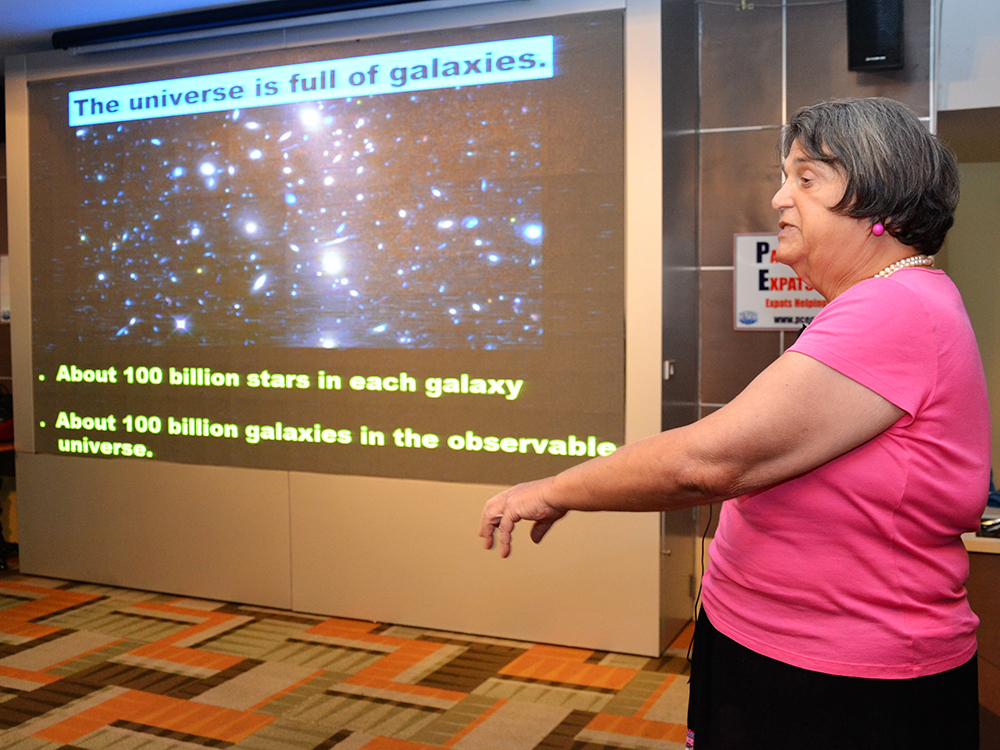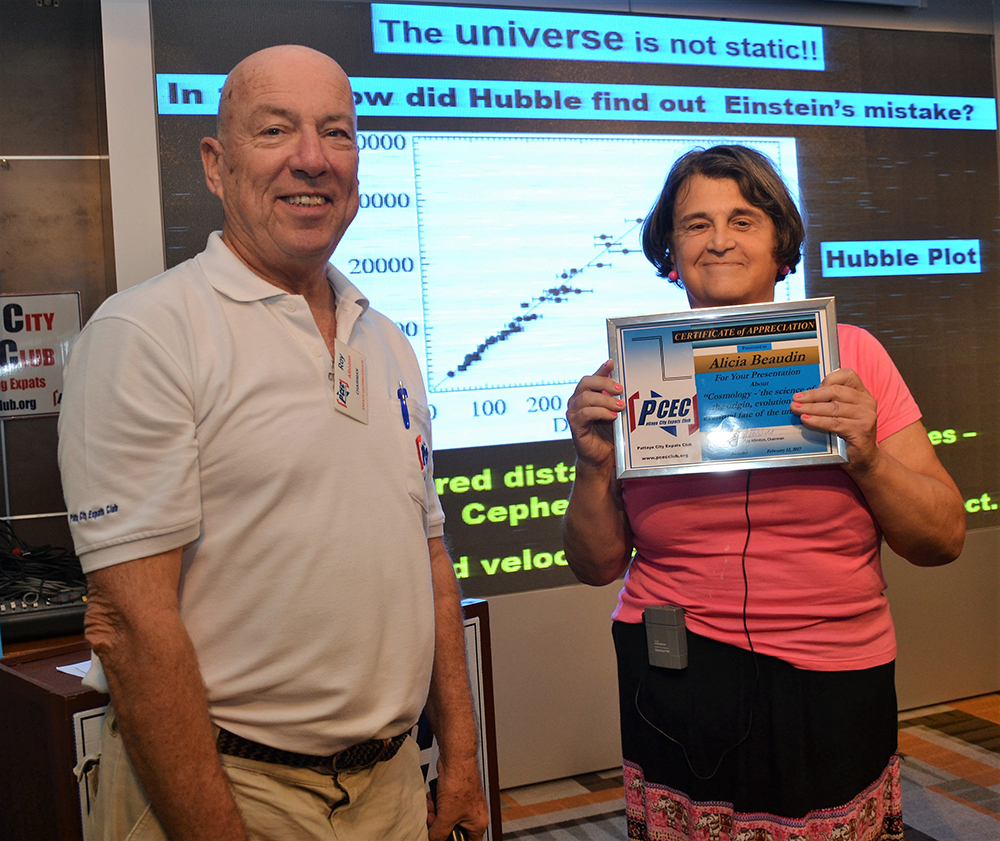Alicia Beaudin presented an interesting program titled, Cosmology, and no, it has nothing to do with Cosmetology. Cosmology deals with the branch of philosophy dealing with the origin and general structure of the universe. Alicia, a new member of the Pattaya City Expats Club, is an honors graduate in physics and has a Master’s Degree in Ocean Engineering. Her professional career involves electrical hardware design and software development. She also has special interests in Quantum Field Theory (QFT) within Theoretical Physics and has an interest in Geophysical Fluid Dynamics.

The program was opened with three basic questions: 1. Why is the universe flat? 2. What is dark matter? & 3. What is cosmology? Two of the questions were explained in two, YouTube, “Physics Girl” videos:
Why is the Universe Flat? – Alicia presented a “Physics Girl” YouTube video to answer this question (https://www.youtube.com/watch?v=MTUsOWtxKKA). Our universe has some peculiar properties that couldn’t be explained by conventional “Big Bang Theories”. The universe is “flat” meaning it has just the right mass density that neither expands forever nor collapses back on itself. So, why should it be “flat” and why should complete opposite sides of the universe have the same temperature?

The “Big Bang Theory” includes the thought that light has not had time to travel from one side of the universe to the other, therefore it wouldn’t have a uniform temperature, which we now know that it does. This first problem of the “Big Bang Theory” is called the “Horizon Problem”, meaning why is the universe so uniform? It wasn’t until the 1980’s that the “Theory of Cosmic Inflation” provided some answers. The theory is that the universe was vastly smaller than it is now. Before inflation, the universe would fit in a volume smaller than 1 billionth of a proton, so light was able to easily traverse the universe. The universe then went through two inflations, growing to 1028 over a 13.8 billion year period. The “Theory of Cosmic Inflation” provides the mechanism for expansion, but it is “Repulsive Gravity” that is thought to have caused the expansion.
As the universe inflates, it gets “flatter and flatter”. The curvature of the universe is defined by the mass density of space, or the amount of energy matter in mass, per volume. If there is a lot of matter per volume, the universe is closed and will collapse on itself. If there is not much matter per volume, the universe is open and will expand forever. If, however, the universe is in perfect balance, and the mass is in or near critical density, it will expand forever, but at an increasingly slower rate, and will eventually stop expanding, causing the geometry of the universe to become more flat. This was demonstrated with the inflation of a balloon. As the balloon inflates the surface becomes more and more flat.

What is Dark Matter? – This question was answered by the second “Physics Girl” YouTube video (https://www.youtube.com/watch?v=XCwWxrx1SIU#t=20.6280684). Dark Matter is simply matter that does not interact with light. It doesn’t reflect light, it doesn’t absorb light, and it doesn’t interact with electromagnetic radiation. The overall “Energy Density” of the universe includes: “Dark Energy”, which makes up 69% of the “Energy Density”, then “Dark Matter” is 26% of the “Energy Density” and only about 5% of the “Energy Density” is “Baryonic Matter” or “Ordinary Matter”. This “Ordinary Matter” includes: me, you, the earth, the solar system, all of the stars, the Milky Way Galaxy and all the galaxies that we can see. So, the question is: How do we know “Dark Matter” is there, if we can’t see it? The answer is explained with the examples of wind and gravity. Neither wind nor gravity can be seen, but their effects can, and the same can be said for “Dark Matter”.
What is Cosmology? – Alicia explained that Cosmology is the “science” of the origin, evolution, and eventual fate of the universe. She asks the question, “What is science?” Answer – Science is the systematic study of the structure and behavior of the physical world through observation and experiment. Scientists develop theories to explain observations and make predictions. Scientists publish papers so that other scientists can duplicate their results.
Cosmology includes our universe, which is full of galaxies. There are about 100 billion stars in each galaxy and 100 billion galaxies in the observable universe. If viewed from above the disc, our own Milky Way galaxy would probably resemble the M100 galaxy (one of the brightest and most visible galaxies, discovered in 1781, by Charles Messie).

The standard “Big Bang Theory” concludes that the universe began 13-14 billion years ago. Its initial state was a hot, dense, uniform soup of particles that filled space uniformly and was expanding rapidly. The “Theory” does not describe the cause of the expansion or where the matter came from. It is thought that there are three types of expansion: 1) A “Spherical Universe Expansion” where the universe expands to a certain radius and then contracts (“Big Crunch”); 2) A “Hyperbolic Universe Expansion”, where the universe always expands but the expansion rate reaches a constant; and 3) A “Flat Universe Expansion” in which the universe always expands but the expansion rate approaches zero.
She concluded by noting that as explained in the first video, “Inflation” can explain the bang, of the “Big Bang Theory”. A positive cosmological constant (“Dark Energy”) explains an accelerating universe and could be vacuum energy or something else. We do not know what makes up 96% of the universe. While dark energy is poorly understood at a fundamental level, the main required properties of dark energy are that it functions as a type of anti-gravity, it dilutes much more slowly than matter as the universe expands, and it clusters much more weakly than matter, or perhaps not at all.
Alicia has started a special interest group for PCEC members and guests interested in Science Books. The Group meets on the 2nd Wednesday of the month.
After the presentations, MC Roy Albiston brought everyone up to date on Club activities and was followed by the Open Forum, where questions are asked and answered or comments made about Expat living in Pattaya.
For more information about the PCEC, visit their website at www.pcecclub.org.




